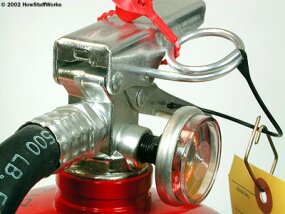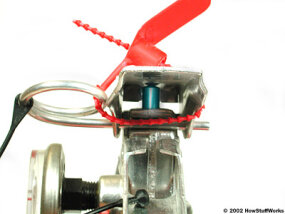https://home.howstuffworks.com/home-improvement/household-safety/fire-extinguisher.htm
How Fire Extinguishers Work
A fire extinguisher is an absolute necessity in any home or office. While there's a good chance that the extinguisher will sit on the wall for years, collecting dust, it could end up saving your property and even your life.
Advertisement
In this article, we'll see exactly what fire extinguishers do and how they do it. We'll also find out what causes fire in the first place, learn the correct way to use an extinguisher and see what sort of fire suppressant works best on different types of fires.
Fire is the result of a chemical combustion reaction, typically a reaction between oxygen in the atmosphere and some sort of fuel (wood or gasoline, for example). Of course, wood and gasoline don't spontaneously catch on fire just because they're surrounded by oxygen. For the combustion reaction to take place, the fuel has to be heated to its ignition temperature.
Fire is the result of a chemical combustion reaction, typically a reaction between oxygen in the atmosphere and some sort of fuel (wood or gasoline, for example). Of course, wood and gasoline don't spontaneously catch on fire just because they're surrounded by oxygen. For the combustion reaction to take place, the fuel has to be heated to its ignition temperature.
Here's the sequence of events in a typical wood fire:
- Something heats the wood to very high temperatures. This could be any number of things -- focused light, friction, something else that is already burning.
- When the wood reaches about 500 degrees Fahrenheit (260 degrees Celsius), the heat decomposes some of the cellulose material that makes up the wood.
- Decomposed material is released as volatile gases, typically a compound of hydrogen, carbon and oxygen.
- When the gas is hot enough, the compound molecules break apart, and the atoms recombine with the oxygen to form water, carbon dioxide and other products.
- The gases, which rise through the air, make up the flame. Carbon atoms rising in the flame emit light as they heat up. (Check out How Light Bulbs Work to find out why heated objects emit light.)
- The heat of the flame keeps the fuel at the ignition temperature, so it continues to burn as long as there is fuel and oxygen.
As you can see, there are three essential elements involved in this process:
- Extreme heat
- Oxygen (or similar gas)
- Fuel
Fire extinguishers are designed to remove at least one of these elements so that a fire will die out. There are several different ways of doing this, as we'll see in the next section.
Advertisement
Inside an Extinguisher
In the last section, we saw that there are three essential elements involved in producing fire -- heat, oxygen and fuel. To put a fire out, you need to effectively remove one of these elements.
- The best way to remove heat is to dump water on the fire. This cools the fuel to below the ignition point, interrupting the combustion cycle.
- To remove oxygen, you can smother the fire so it is not exposed to air. One way to smother a small fire is to cover it with a heavy blanket. Another way is to dump nonflammable material, such as sand or baking soda on top of it.
- Removing the fuel is the most difficult approach for most fires. In a house fire, for example, the house itself is potential fuel. The fuel will only be removed once the fire has burned all of it up.
Fire extinguishers are sturdy metal cylinders filled with water or a smothering material. When you depress a lever at the top of the cylinder, the material is expelled by high pressure, similar to the way material is forced out of an aerosol can. The diagram below shows a typical design.
Advertisement
This content is not compatible on this device.
In this extinguisher, a plastic siphon tube leads from the bottom of the fire-suppressant reservoir to the top of the extinguisher. A spring-mounted valve blocks the passageway from the siphon to the nozzle. At the top of the cylinder, there is a smaller cylinder filled with a compressed gas -- liquid carbon dioxide, for example. A release valve keeps the compressed gas from escaping.
To use the extinguisher, you pull out the safety pin and depress the operating lever. The lever pushes on an actuating rod, which presses the spring-mounted valve down to open up the passage to the nozzle. The bottom of the actuating rod has a sharp point, which pierces the gas cylinder release valve.


The compressed gas escapes, applying downward pressure on the fire-suppressant material. This drives the material up the siphon and out the nozzle with considerable force. The proper way to use the extinguisher is to aim it directly at the fuel, rather than the flames themselves, and move the stream with a sweeping motion.
In the next section, we'll look at the major types of extinguishers.
Advertisement
Types of Extinguishers
Water is the most familiar extinguishing material, and it is one of the most effective. But it can be dangerous in the wrong situation. A water extinguisher can put out things like burning wood, paper or cardboard, but it does not work well on electrical fires or fires involving inflammable liquids. In an electrical fire, the water may conduct the current, which can electrocute you. Water will only spread out an inflammable liquid, which will most likely make the fire worse.
One popular extinguisher material is pure carbon dioxide. In a carbon dioxide extinguisher, the carbon dioxide is kept in pressurized liquid form in the cylinder. When the container is opened, the carbon dioxide expands to form a gas in the atmosphere. Carbon dioxide gas is heavier than oxygen, so it displaces the oxygen surrounding the burning fuel. This sort of fire extinguisher is common in restaurants because it won't contaminate the cooking equipment or food.
Advertisement
The most popular extinguisher material is dry chemical foam or powder, typically made of sodium bicarbonate (normal baking soda), potassium bicarbonate (nearly identical to baking soda), or monoammonium phosphate. Baking soda starts to decompose at only 158 degrees Fahrenheit (70 degrees Celsius), and when it decomposes, it releases carbon dioxide. The carbon dioxide, along with the insulation of the foam, works to smother the fire.
Most fire extinguishers contain a fairly small amount of fire-suppressant material -- you can use it all up in a matter of seconds. For this reason, extinguishers are only effective on relatively small, contained fires. To put out a larger fire, you need much bigger equipment -- a fire engine, for example -- and the professionals who know how to use it. But for the dangerous flames that can pop up in your house, a fire extinguisher is an invaluable lifesaver.
To learn more about fire extinguishers and other fire-fighting equipment, check out the links on the next page.
Advertisement
Lots More Information
Related HowStuffWorks Articles
More Great Links
Advertisement




No comments:
Post a Comment